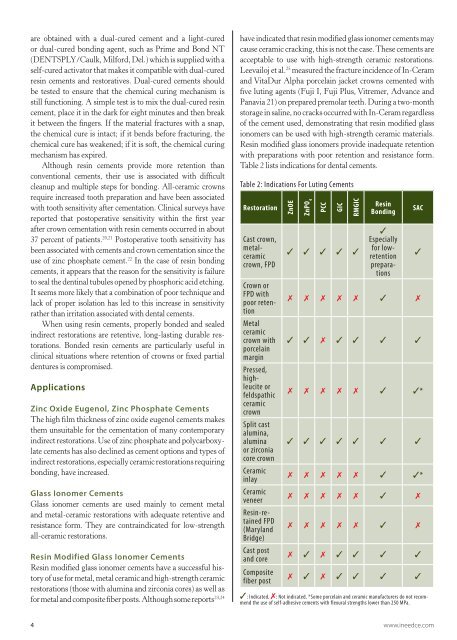A Practical Guide to the Use of Luting Cements - IneedCE.com
A Practical Guide to the Use of Luting Cements - IneedCE.com
A Practical Guide to the Use of Luting Cements - IneedCE.com
Create successful ePaper yourself
Turn your PDF publications into a flip-book with our unique Google optimized e-Paper software.
are obtained with a dual-cured cement and a light-cured<br />
or dual-cured bonding agent, such as Prime and Bond NT<br />
(DENTSPLY/Caulk, Milford, Del.) which is supplied with a<br />
self-cured activa<strong>to</strong>r that makes it <strong>com</strong>patible with dual-cured<br />
resin cements and res<strong>to</strong>ratives. Dual-cured cements should<br />
be tested <strong>to</strong> ensure that <strong>the</strong> chemical curing mechanism is<br />
still functioning. A simple test is <strong>to</strong> mix <strong>the</strong> dual-cured resin<br />
cement, place it in <strong>the</strong> dark for eight minutes and <strong>the</strong>n break<br />
it between <strong>the</strong> fingers. If <strong>the</strong> material fractures with a snap,<br />
<strong>the</strong> chemical cure is intact; if it bends before fracturing, <strong>the</strong><br />
chemical cure has weakened; if it is s<strong>of</strong>t, <strong>the</strong> chemical curing<br />
mechanism has expired.<br />
Although resin cements provide more retention than<br />
conventional cements, <strong>the</strong>ir use is associated with difficult<br />
cleanup and multiple steps for bonding. All-ceramic crowns<br />
require increased <strong>to</strong>oth preparation and have been associated<br />
with <strong>to</strong>oth sensitivity after cementation. Clinical surveys have<br />
reported that pos<strong>to</strong>perative sensitivity within <strong>the</strong> first year<br />
after crown cementation with resin cements occurred in about<br />
37 percent <strong>of</strong> patients. 20,21 Pos<strong>to</strong>perative <strong>to</strong>oth sensitivity has<br />
been associated with cements and crown cementation since <strong>the</strong><br />
use <strong>of</strong> zinc phosphate cement. 22 In <strong>the</strong> case <strong>of</strong> resin bonding<br />
cements, it appears that <strong>the</strong> reason for <strong>the</strong> sensitivity is failure<br />
<strong>to</strong> seal <strong>the</strong> dentinal tubules opened by phosphoric acid etching.<br />
It seems more likely that a <strong>com</strong>bination <strong>of</strong> poor technique and<br />
lack <strong>of</strong> proper isolation has led <strong>to</strong> this increase in sensitivity<br />
ra<strong>the</strong>r than irritation associated with dental cements.<br />
When using resin cements, properly bonded and sealed<br />
indirect res<strong>to</strong>rations are retentive, long-lasting durable res<strong>to</strong>rations.<br />
Bonded resin cements are particularly useful in<br />
clinical situations where retention <strong>of</strong> crowns or fixed partial<br />
dentures is <strong>com</strong>promised.<br />
Applications<br />
Zinc Oxide Eugenol, Zinc Phosphate <strong>Cements</strong><br />
The high film thickness <strong>of</strong> zinc oxide eugenol cements makes<br />
<strong>the</strong>m unsuitable for <strong>the</strong> cementation <strong>of</strong> many contemporary<br />
indirect res<strong>to</strong>rations. <strong>Use</strong> <strong>of</strong> zinc phosphate and polycarboxylate<br />
cements has also declined as cement options and types <strong>of</strong><br />
indirect res<strong>to</strong>rations, especially ceramic res<strong>to</strong>rations requiring<br />
bonding, have increased.<br />
Glass Ionomer <strong>Cements</strong><br />
Glass ionomer cements are used mainly <strong>to</strong> cement metal<br />
and metal-ceramic res<strong>to</strong>rations with adequate retentive and<br />
resistance form. They are contraindicated for low-strength<br />
all-ceramic res<strong>to</strong>rations.<br />
Resin Modified Glass Ionomer <strong>Cements</strong><br />
Resin modified glass ionomer cements have a successful his<strong>to</strong>ry<br />
<strong>of</strong> use for metal, metal ceramic and high-strength ceramic<br />
res<strong>to</strong>rations (those with alumina and zirconia cores) as well as<br />
for metal and <strong>com</strong>posite fiber posts. Although some reports 23,24<br />
have indicated that resin modified glass ionomer cements may<br />
cause ceramic cracking, this is not <strong>the</strong> case. These cements are<br />
acceptable <strong>to</strong> use with high-strength ceramic res<strong>to</strong>rations.<br />
Leevailoj et al. 25 measured <strong>the</strong> fracture incidence <strong>of</strong> In-Ceram<br />
and VitaDur Alpha porcelain jacket crowns cemented with<br />
five luting agents (Fuji I, Fuji Plus, Vitremer, Advance and<br />
Panavia 21) on prepared premolar teeth. During a two-month<br />
s<strong>to</strong>rage in saline, no cracks occurred with In-Ceram regardless<br />
<strong>of</strong> <strong>the</strong> cement used, demonstrating that resin modified glass<br />
ionomers can be used with high-strength ceramic materials.<br />
Resin modified glass ionomers provide inadequate retention<br />
with preparations with poor retention and resistance form.<br />
Table 2 lists indications for dental cements.<br />
Table 2: Indications For <strong>Luting</strong> <strong>Cements</strong><br />
Res<strong>to</strong>ration<br />
Cast crown,<br />
metalceramic<br />
crown, FPD<br />
Crown or<br />
FPD with<br />
poor retention<br />
Metal<br />
ceramic<br />
crown with<br />
porcelain<br />
margin<br />
Pressed,<br />
highleucite<br />
or<br />
feldspathic<br />
ceramic<br />
crown<br />
Split cast<br />
alumina,<br />
alumina<br />
or zirconia<br />
core crown<br />
Ceramic<br />
inlay<br />
Ceramic<br />
veneer<br />
Resin-retained<br />
FPD<br />
(Maryland<br />
Bridge)<br />
Cast post<br />
and core<br />
Composite<br />
fiber post<br />
ZnOE<br />
ZnPO 4<br />
PCC<br />
GIC<br />
RMGIC<br />
✓ ✓ ✓ ✓ ✓<br />
Resin<br />
Bonding<br />
✓<br />
Especially<br />
for lowretention<br />
preparations<br />
SAC<br />
✗ ✗ ✗ ✗ ✗ ✓ ✗<br />
✓ ✓ ✗ ✓ ✓ ✓ ✓<br />
✗ ✗ ✗ ✗ ✗ ✓ ✓*<br />
✓ ✓ ✓ ✓ ✓ ✓ ✓<br />
✗ ✗ ✗ ✗ ✗ ✓ ✓*<br />
✗ ✗ ✗ ✗ ✗ ✓ ✗<br />
✗ ✗ ✗ ✗ ✗ ✓ ✗<br />
✗ ✓ ✗ ✓ ✓ ✓ ✓<br />
✗ ✓ ✗ ✓ ✓ ✓ ✓<br />
✓: Indicated. ✗: Not indicated. *Some porcelain and ceramic manufacturers do not re<strong>com</strong>mend<br />
<strong>the</strong> use <strong>of</strong> self-adhesive cements with flexural strengths lower than 250 MPa.<br />
✓<br />
4 www.ineedce.<strong>com</strong>
















